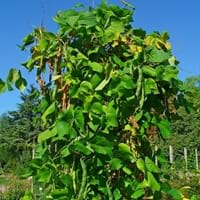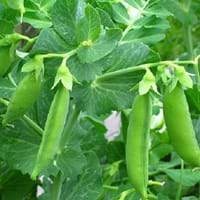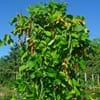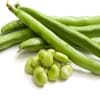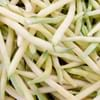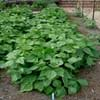Life Span
Perennial
Annual
Origin
Central America
Mediterranean
Types
Not Available
Sugar Bon pea, Super Sugar Snap bean
Number of Varieties
Not Available
Habitat
Fields, orchards
Fields, Loamy soils
USDA Hardiness Zone
8-11
Not Available
Sunset Zone
A1, A2, A3, H1, H2, 1a, 1b, 2a, 2b, 3a, 3b, 4, 5, 6, 7, 8, 9, 10, 11, 12, 13, 14, 15, 16, 17, 18, 19, 20, 21, 22, 23, 24
A1, A2, A3, H1, H2, 1a, 1b, 2a, 2b, 3a, 3b, 4, 5, 6, 7, 8, 9, 10, 11, 12, 13, 14, 15, 16, 17, 18, 19, 20, 21, 22, 23, 24
Habit
Vining/Climbing
Vining/Climbing
Flower Color
White, Red, Crimson
White, Pink, Lavender
Flower Color Modifier
Bicolor
Bicolor
Fruit Color
Green, Tan, Brown
Green
Leaf Color in Spring
Green, Dark Green
Green, Sea Green, Gray Green
Leaf Color in Summer
Green, Dark Green
Not Available
Leaf Color in Fall
Green, Dark Green
Green, Blue Green, Gray Green
Leaf Color in Winter
Green, Dark Green
Green, Blue Green, Gray Green
Leaf Shape
Maple shaped
Egg-shaped
Plant Season
Spring, Summer, Fall, Winter
Spring, Fall, Winter
Sunlight
Full Sun, Partial Sun
Full Sun, Partial Sun
Type of Soil
Clay, Loam, Sand
Clay, Loam, Sand
The pH of Soil
Neutral
Neutral
Soil Drainage
Well drained
Well drained
Bloom Time
Indeterminate
Early Spring, Spring, Late Spring, Fall, Late Fall, Early Winter, Winter, Late Winter
Tolerances
Drought
Dry Conditions, Salt and Soil Compaction, Variety of soil types
Where to Plant?
Container, Ground
Ground
How to Plant?
Seedlings
Seedlings
Plant Maintenance
Medium
Medium
Watering Requirements
Do not let dry out between waterings, Use Mulches to help prevent water loss during hot and windy weather
Allow to dry out slightly between watering, Needs watering once a week
In Summer
Lots of watering
Consistently
In Spring
Moderate
Adequately
In Winter
Average Water
Less Watering
Soil pH
Neutral
Slightly Acidic
Soil Type
Clay, Loam, Sand
Clay, Loam, Sand
Soil Drainage Capacity
Well drained
Well drained
Sun Exposure
Full Sun, Partial Sun
Full Sun, Partial Sun
Pruning
Remove damaged leaves, Remove dead branches, Remove dead leaves
No pruning needed, Prune in flowering season, Remove damaged leaves
Fertilizers
All-Purpose Liquid Fertilizer
Compost, fertilize in winter
Pests and Diseases
Red blotch
Downy mildew, Gall Insects, Leaf curl, Peach Leaf Curl, Powdery mildew, Root rot
Plant Tolerance
Drought
Light Frost
Flower Petal Number
Single
Single
Foliage Texture
Medium
Medium
Foliage Sheen
Matte
Matte
Attracts
Hummingbirds
Not Available
Allergy
Diarrhea, Irritation to stomach
Diarrhea, Intestinal gas
Aesthetic Uses
Not Used For Aesthetic Purpose
As decorated salad
Beauty Benefits
Making cosmetics, Remove blemishes
Remove blemishes, Skin Problems
Environmental Uses
Air purification
Fixes Nitrogen, Food for animals, Very little waste
Medicinal Uses
Acne, Diuretic, Emmoiliant, Menstrual Disorders
No Medicinal Use
Part of Plant Used
Fruits
Leaves, Seeds
Other Uses
Animal Feed, Used as a nutritious food item
Cosmetics, Making Shampoo, Used as a nutritious food item, Used As Food
Used As Indoor Plant
Yes
No
Used As Outdoor Plant
Yes
Yes
Garden Design
Edible, Herb, Vegetable, Mixed Border, Tropical, Vine
Container, Edible, Herb, Vegetable, Vine
Botanical Name
PHASEOLUS coccineus
PISUM sativum
Common Name
Runner bean, Multiflora bean
Garden Pea
In Hindi
Scarlet Runner Bean
चीनी मटर
In German
Feuerbohne
Kefe
In French
Haricot d'Espagne
Erbse
In Spanish
Ayocote
guisante
In Greek
Scarlet Runner Bean
μπιζέλι
In Portuguese
Feijão-da-espanha
ervilha
In Latin
Scarlet Runner Bean
pea
Phylum
Spermatophyta
Magnoliophyta
Class
Magnoliopsida
Magnoliopsida
Clade
Angiosperms, Eudicots, Rosids
Dicotyledonous
Tribe
Phaseoleae
Not Available
Subfamily
Faboideae
Not Available
Number of Species
Not Available
Season and Care of Scarlet Runner Bean and Sugar Snap Pea
Season and care of Scarlet Runner Bean and Sugar Snap Pea is important to know. While considering everything about Scarlet Runner Bean and Sugar Snap Pea Care, growing season is an essential factor. Scarlet Runner Bean season is Spring, Summer, Fall and Winter and Sugar Snap Pea season is Spring, Summer, Fall and Winter. The type of soil for Scarlet Runner Bean is Clay, Loam, Sand and for Sugar Snap Pea is Clay, Loam, Sand while the PH of soil for Scarlet Runner Bean is Neutral and for Sugar Snap Pea is Neutral.
Scarlet Runner Bean and Sugar Snap Pea Physical Information
Scarlet Runner Bean and Sugar Snap Pea physical information is very important for comparison. Scarlet Runner Bean height is 180.00 cm and width Not Available whereas Sugar Snap Pea height is 30.00 cm and width Not Available. The color specification of Scarlet Runner Bean and Sugar Snap Pea are as follows:
Scarlet Runner Bean flower color: White, Red and Crimson
Scarlet Runner Bean leaf color: Green and Dark Green
Sugar Snap Pea flower color: White, Pink and Lavender
- Sugar Snap Pea leaf color: Green, Sea Green and Gray Green
Care of Scarlet Runner Bean and Sugar Snap Pea
Care of Scarlet Runner Bean and Sugar Snap Pea include pruning, fertilizers, watering etc. Scarlet Runner Bean pruning is done Remove damaged leaves, Remove dead branches and Remove dead leaves and Sugar Snap Pea pruning is done No pruning needed, Prune in flowering season and Remove damaged leaves. In summer Scarlet Runner Bean needs Lots of watering and in winter, it needs Average Water. Whereas, in summer Sugar Snap Pea needs Consistently and in winter, it needs Less Watering.
